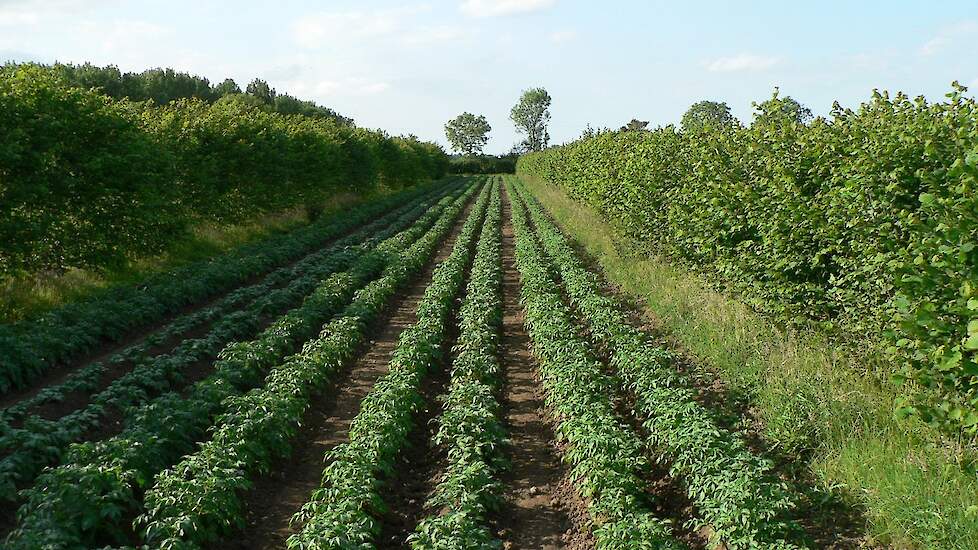The first large-scale agroforestry project is taking shape in a field of 15 hectares in Lelystad. On this plot, WUR will investigate the relationship between rows of trees and hedges and various arable crops. According to WUR, agroforestry has the potential to simultaneously contribute to various environmental, agricultural and economic aspects.
With the planting of the first trees and hedges on a 15-hectare plot in Lelystad, Wageningen University & Research (WUR) has launched the first large-scale multidisciplinary research facility for agroforestry. Various tree species and hedges are planted in Lelystad, in combination with annually changing annual crops such as potatoes, grains and cabbage. The research facility is located at the Open Crops business unit.
Experimental basis
“The Agroforestry project has been running in the Netherlands for several years. Various persons and agencies have started to work with it on an experimental basis. Now we are taking it on a larger scale and scientifically. To this end, we now have a plot of 15 hectares. We will grow various crops organically in a rotation of one in eight. In this way we can register the effects on the various crops. We will certainly be growing crops in this way on these 15 hectares for the next 10 to 15 years. ” That says project manager Maureen Schoutsen of WUR.
Agricultural system
Agroforestry is an agricultural system in which trees and woody (perennial) crops are combined with arable or vegetable cultivation (annual crops) or livestock farming on one plot. By combining these crops, the resilience of the entire agricultural system can be increased. Agroforestry is increasingly referred to as a sustainable and innovative form of agriculture. According to WUR, Agroforestry has the potential to contribute to: the production of food, animal feed and biomass, the efficient use of ecological resources, CO2 sequestration, strengthening the above- and underground resilience of the agricultural system, increasing biodiversity, shelter for livestock, economic resilience of the agricultural business by spreading risk and offering a recreational landscape.
Limited knowledge of mixed crops
According to WUR, mixed crops have the potential to perform better economically and ecologically than monocultures. But there is still insufficient knowledge and experience in the specific field of mixed cultivation of woody crops with annual arable and vegetable crops. The WUR researchers want to find answers to questions such as: What does agroforestry yield to production and soil fertility? Does it affect resilience and disease and pest pressure? How can you integrate nature and biodiversity into profitable business operations? What opportunities and obstacles are there for these types of combinations? The facility will be equipped with sensors to collect data on (micro) climate, wind (speed) and soil condition (soil temperature and moisture).
Positive Effects
The expected positive effects on arable crops come down to less damage from pests and diseases, a better microclimate and better soil quality for crop growth. According to WUR, lan cultivation can be regarded as a form of strip cultivation. The current research on strip cultivation with annual crops suggests a 20-75 percent reduction in disease and pest pressure. A meta-analysis of pests in lan cultivation published earlier by WUR shows that on average there are 24 percent more natural enemies and 25 percent fewer arthropod pest species in these plots.
Negative effects

The negative effects of agroforestry on arable crops are caused by, for example, competition for light, water and nutrients. In most cases this leads to a reduction in yield near the tree strips. Yields are generally higher at a greater distance from the trees than in an open field. This is because of a better microclimate. Effects such as a higher temperature, increased soil moisture due to lower evaporation and reduced crop damage from wind and heat are responsible for this. A summary study of agroforestry systems with grains, maize and soy shows an expected negative effect on crop yield next to tree strips. This effect plays up to a distance of about 1.6 times the tree height. This equates to an average of 30 percent less crop yield on this part of the plot.
Potency
According to a WUR fact sheet, agroforestry has the potential to achieve yield increases in arable crops and possibly also in woody crops. This on the condition of a well-designed system where a lot of attention is paid to the crop interactions. Choice of woody varieties, row spacing and planting density will determine whether the system performs well. In addition to these aspects, careful consideration must be given in advance to the economic consequences for the construction plan balance and the opportunities for marketing tree fruits and processed products. With the further development of revenue models, agroforestry can become an interesting economic activity for agricultural entrepreneurs. In addition, if financial benefits are provided for social services, such as carbon sequestration and biodiversity.


